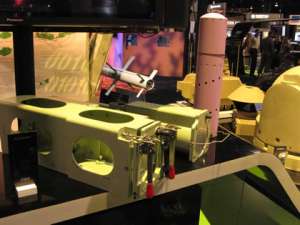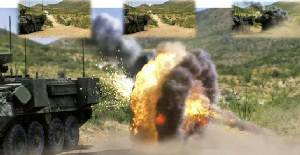| Designation: | Quick Kill |
 |
|---|---|---|
| Manufacturer: | Raytheon Systems Company | |
| Product type: | Protection Systems | |
| Name: | Active protection system |
Quick Kill APS detected incoming RPGs and anti-tank missiles with an active electronically scanned array radar. Once its speed, trajectory and intercept point were computed, Quick Kill vertically launched a small countermeasure missile. The system featured two types of missiles: a smaller one for defense against close range weapons such as RPGs, and another, larger one to intercept longer range, faster anti-tank missiles or shells. The countermeasure missile intercepted the incoming threat and destroyed it with a focused blast warhead. The Quick Kill missile had 360-degree capability and a reload capability, with each launcher typically containing 8 to 16 missiles. It could be used stationary or on the move with a wide range of vehicles from armored personnel carriers to airborne helicopters.
It was reported that the Humvee or JLTV would not be suitable for the Quick Kill APS, due to the blast pressures generated when the incoming warhead detonates, which was likely to buckle lightly armored vehicles.
On Feb 8, 2006, Raytheon issued a press release stating that their "Quick Kill System [was] the first active protection system (APS) to destroy a rocket propelled grenade (RPG) at close range, using a precision launched warhead with a focused blast" during live fire testing done the day before. However, this was not the first time an Active Protection System (APS) successfully engaged an incoming munition. The Soviet Drozd active protection system was equipped to Soviet tanks in the early 1980s, and saw significant use in the Soviet war in Afghanistan on older model tanks. Later, during a 1995 special armor conference in Kubinka, a Soviet T-72 tank fitted with an updated version of APS (most likely the Arena Active Protection System) successfully protected against KONKURS ATGMs and RPG-type weapons.
Controversy ignited when the United States Office of Force Transformation (OFT) planned to battle-test the more mature, but Israeli-made Trophy active protection system on several Stryker armored personnel carriers headed for Iraq in early 2007. The effort was scuttled by the Army in favor of waiting for the Quick Kill system to develop. In 2006–2007, the Institute for Defense Analysis found Quick Kill to be relatively immature and fraught with significant development risks. Important components like the radar were not yet fully developed and testing of the system as a whole was on hold while the warhead was redesigned. They also found Trophy, which uses a shotgun-like kill mechanism, to be the most mature of the 15 systems they analyzed at the time.
In a test, held in December 2012, the Quick Kill APS demonstrated its protective capability by successfully defeating an extended set of threats, including one of the most lethal RPG threats by destroying it in mid-flight.
The Quick Kill system consists of a multi-mission, fire-control radar that detects and tracks incoming threats, combined with hard-kill countermeasures that serve as a hit avoidance system, enabling multi-tracking and multi-engagement of enemy fire for vehicle and squad protection.
The system's vertical launch countermeasure is unique in its ability to engage threats fired from any angle or elevation, providing all weather, full 360 degree hemispherical vehicle and crew protection with each countermeasure.
 |
 |
 |
